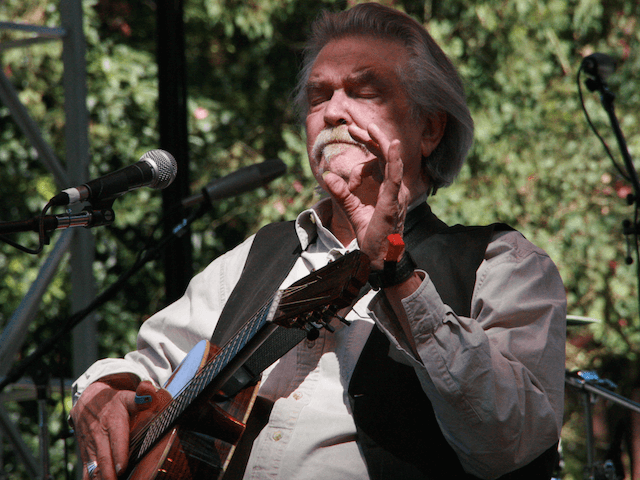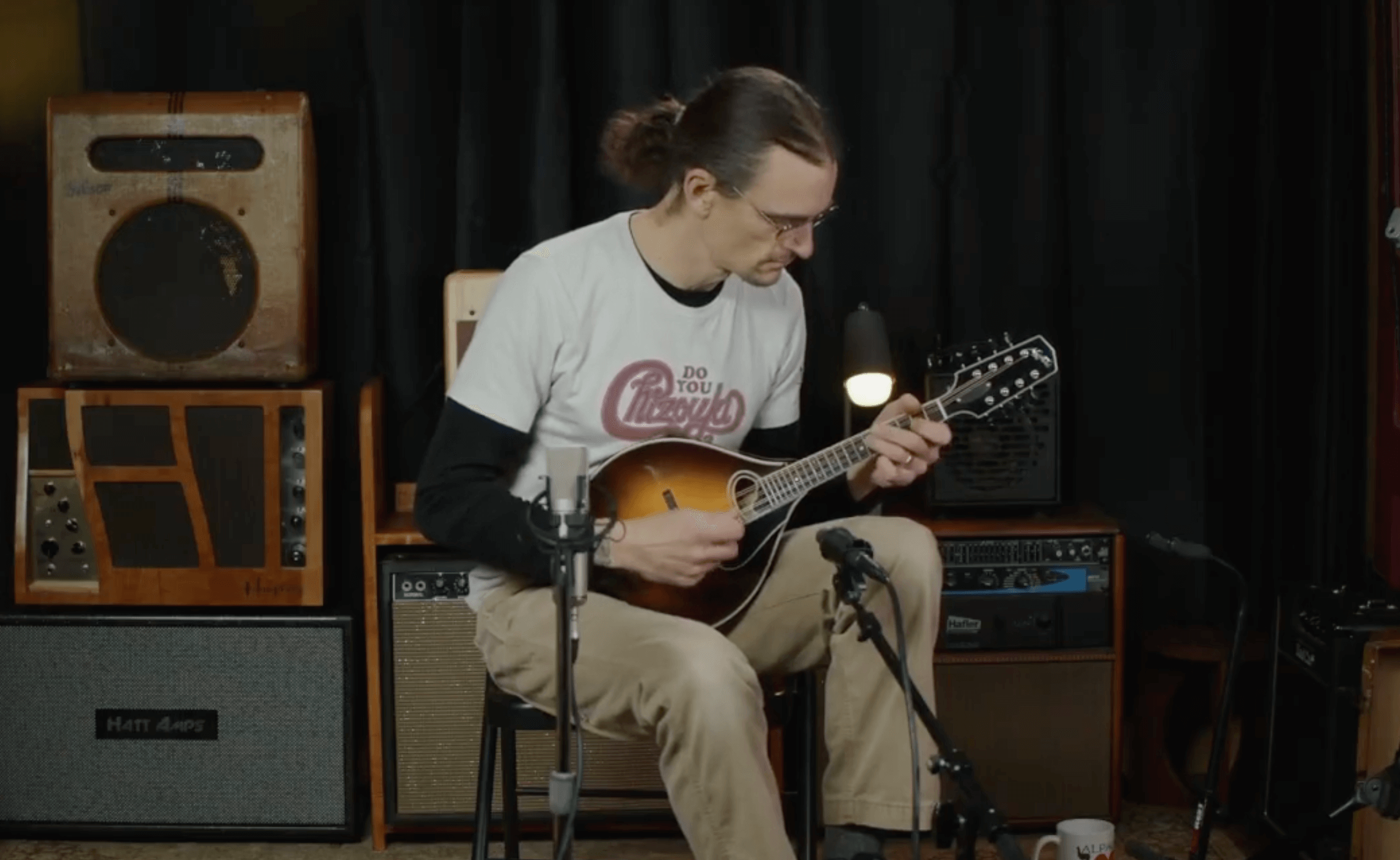Rick Turner, 1943 – 2022
Remembering the legendary luthier and audio genius.
When renowned luthier Rick Turner passed away at the age of 78 on April 17, he left behind an almost unfathomable legacy. A New Englander from Marblehead, Massachusetts, Rick began working on instruments during stays on Martha’s Vineyard in the early 1960s. He then became an active part in the emerging folk and rock music movements in Cambridge and Greenwich Village before settling in the San Francisco Bay Area toward the end of the decade.
 Rick had a gift for working not only with wood, but also with metal and electronics, and watching him work was a study in skill, confidence, and efficiency. He began working as a live sound engineer at the same time that he started building and modifying instruments, which led to his connections with the Grateful Dead and other leading Bay Area acts of the era. In the early 1970s, these multiple talents served Rick well when he co-founded Alembic Instruments, where he spearheaded innovations in electric bass and guitar design. During this time, he also worked on and helped run the Grateful Dead’s infamous “Wall of Sound” PA system and experimented with early remote recording.
Rick had a gift for working not only with wood, but also with metal and electronics, and watching him work was a study in skill, confidence, and efficiency. He began working as a live sound engineer at the same time that he started building and modifying instruments, which led to his connections with the Grateful Dead and other leading Bay Area acts of the era. In the early 1970s, these multiple talents served Rick well when he co-founded Alembic Instruments, where he spearheaded innovations in electric bass and guitar design. During this time, he also worked on and helped run the Grateful Dead’s infamous “Wall of Sound” PA system and experimented with early remote recording.
In 1978, Rick left Alembic and created his innovative Model 1 electric guitar, which became closely associated with Fleetwood Mac’s Lindsey Buckingham, and which would remain at the center of Rick’s output for the rest of his career. While working at Westwood Music in Los Angeles, he became a repair tech to the stars and continued his involvement with high-end audiophile recording, becoming a major force in the advancement of acoustic instrument amplification.
Rick began creating custom piezo pickups and then co-founded both Highlander and D-TAR. With his own line of Renaissance guitars and basses he pioneered the concept of marrying electric instruments with acoustic tonalities.
I first met Rick in 1998 when I was Acoustic Guitar magazine’s gear editor. For the next 16 years, we collaborated on countless articles, and I learned that besides all of the obvious talents of his that I’d heard about, he was also a great writer who was able to convey complicated repair topics to non-luthiers.
We soon became friends and I’d visit his shop at least a couple of times each year, always looking forward not only to seeing what he was working on, but also hearing the stories that he’d inevitably tell. Rick was incredibly down-to-earth and he certainly wasn’t a name-dropper, but his life had revolved around working for many of the best players in the industry for so long that I don’t think he even noticed when he said things like “The other half of that is the pickguard on Ry Cooder’s Strat” while pointing to a sheet of tiger-striped plastic hanging on his wall, or saying “Martin Simpson told me he thought that’s the best guitar he’s ever played” while handing me one of his vintage Howe-Orme guitars to check out.

In April, I visited Rick in Santa Cruz the day before he would leave for the Skull and Roses festival in Ventura, and found that even the COVID lockdowns couldn’t slow Rick down. His shop remained as busy as ever. He was still innovating guitar designs and working on instrument-mounted microphones for a variety of acoustic instruments, and he was tickled by the attention he was once again getting from the Grateful Dead community, in part through projects such as his restoration of Jerry Garcia’s modified “Alligator” Stratocaster.
While attending the Skull and Roses festival, Rick fell ill and checked himself into a hospital, where he succumbed to congestive heart failure and a stroke.
As a tribute to Rick, we are running part of a lengthy interview I did with him in 2013, much of which was about Rick’s early days. Below is the first section of this interview, starting with his earliest days working on instruments, being around the Grateful Dead, co-founding Alembic, designing his iconic Model 1, and ultimately taking a break from full-time instrument making. We’ll run a second portion of the interview in the near future.
There are so many aspects of your work we could talk about, but can we start with a basic timeline of how you got started?
There are the early days in Cambridge, and then there’s the period with the band, in New York, which is really when I started to modify instruments.
Who were your mentors at that time? Who did you learn from?
In Boston, there was a stringed instrument workshop which was a couple of guys, Don Gadbois and Stan Stansky. Don was a jazz guitar player, scared to death of tools that might hurt his hands. But Stan was a cabinet maker who knew nothing about guitars. Between the two of them they were able to make a go at it, and given that this was the dark ages of guitar—this is 1963—there were just two books on guitar making, both little books from England.
So this is before the Irving Sloane book?
Oh yeah, years before the Sloane book. We’re talking serious dark ages of it all. It’s about the time when a bunch of other people were figuring it out, you know, Michael Gurian, Stu Mossman, Dan Armstrong. You could consider Dan Armstrong to be an inspiration and a guru. When I lived in New York in 1967 and early ’68, if I was broke, I could go down to Dan’s shop in the village and say, “Hey, you got a fret job or something you need done?” You know, pick up a quick ten bucks or something like that.
But, it was also the time —’67, ’68, ’69—when that group of us, like Bob Taylor and so on, were just starting to figure it out for ourselves. Pretty much all of the knowledge on steel-string guitar making and electric guitar making was tied up in the guitar factories. The knowledge was there, at Martin, Guild, Gibson, Fender, and so on, and if you had serious work you needed done on your guitar, you sent it back to the factory.
The first person I knew that started messing around with pickups was Dan Armstrong, with the help of Billy Lorenzo (Bill Lawrence). And I sort of got it when I moved out to California, and the band didn’t follow, which I thought was gonna happen. It was like, “OK, well, what do I do now?” And one of the things I decided to do was be an electric guitar maker.
When was that?
And, so you know, you couldn’t just buy pickups. You could get DeArmonds for archtops, but Gibson didn’t sell pickups, and Seymour Duncan or Larry DiMarzio weren’t making them yet. Buy a guitar pickup? That was ridiculous! But from observing what Dan had been up to, I knew what the pickup is, you know, you got a magnet structure, and you have pole pieces, and you got coil wire; it’s as simple as that. And then I wound up in West Marin, because I was good friends with the Youngbloods. And my wife at the time was best friends with Jesse Colin Young’s wife, and Banana [Lowell Levinger] and I had been roommates in Cambridge, and he was already in Ross.
So in 1969, I wound up going on the road with them, and mixing sound, basically being a roadie. The Youngbloods’ office was in Point Reyes, and through a connection with the manager and his secretary, a woman named Florence, whose boyfriend was Phil Lesh, I was introduced to Phil, who invited me to come out to the Dead’s rehearsal place.
Ron Wickersham had come up with a way to measure the frequency response of pickups. At that time, it was the bass players who were most interested in advancing the state of the art, and that really meant Phil Lesh and Jack Casady. They were more interested in extending the frequency response of the pickups than the guitar players. Jesse Colin Young commissioned the first electric bass, and I made the pickups. Ron measured the frequency response of the pickups that I was making, and they were literally off the chart compared to everything else he measured. The output was low. I was literally handwinding and hand cranking each pickup, and after about 1,000 turns, I got tired! 
So we went through an elaborate set of experiments. It’s stuff that everybody knows now, but in 1969, it was all new. I would keep the magnet structures the same on a pickup, and I built this little coil winder with a counter on. But I was still hand guiding the wire. I’d wind coils with different numbers of turns and different sizes of wire. And we would measure them, and pretty soon we got it: more turns is more output and more limited bandwidth frequency response. Since Ron had already started doing some onboard electronics with discrete transistor preamps for pickups, he’s going “Well, we don’t need the gain from the pickup, we can get it from really clean discrete transistor preamps!” So right from the get-go, working with Ron in what became Alembic, the idea was to get as much out of the pickup as we could and then make the rest up with active electronics.
And you get into this whole thing of like, well, an electric guitar is it active, or is it passive? Well, one way to look at it is, if it’s an electric guitar, and you look at it systematically, it’s active. And the only difference is where your first stage of amplifying electronics is. Is it in a box that calls itself an amplifier that has a preamp there, or is it in the guitar? So all electric guitars are active. It’s just a matter of where the preamp is.
At this time, many of the guitars we now consider to be the holy grail of vintage guitar designs were basically just used guitars. What shortcomings were you trying to address with your own designs?
One thing we were trying to come up with was something that would be original and different. The other was that we were trying to come up with a system that would allow you to overlay certain sonic characteristics onto these pickups. So the electronics that Ron came up with eventually became our standard. It became a very useful set of electronics, primarily for electric bass. Bass players had gotten into recording direct, and so the amplifier per se was not as important. We found much more success with bass players who wanted to hear wider frequency, wanted to have the clarity at their fingertips.
Alembic incorporated in 1970, and when we did, I was as likely to be out mixing a giant PA system with the Grateful Dead or whoever, as I was to be building instruments or winding pickups. But I also wound up working as a second engineer with our recording rig. I think we had the world’s first live 16-track tape recording rig; literally dragging that 860 pound Ampex MN-1000 around the world!
And this was with the Grateful Dead?
Yeah, we recorded the Dead and the Airplane and the Great Medicine Ball Caravan; we did B.B. King, Jim Morrison, went to England and worked with Pink Floyd, Rod Stewart, Small Faces, James Taylor, and Santana. We were working with everybody, one way or another, doing radio broadcasts or recording.
We made a lot of our own stuff. You couldn’t go to Sweetwater and buy a snake; you had to make the thing! I learned how to solder on my back underneath a recording console! You get good at it, especially when you’re working around the people I was working around. Ron had come out of Ampex, and then there was Owsley, who was so anal about military, industrial-grade soldering and stuff like that. In retrospect, it was remarkable, because it was literally state-of-the art; nobody else was pushing things like that. And we had budgets, thanks to Crosby, Stills and Nash, and the Grateful Dead, and Jefferson Airplane, and Santana and so on. As long as we showed that we were pushing things forward, there was money for it.
Did you play music at this time?
I was not playing music much at this time. Although I was accepted among the various players.
You were playing before you were building and working on instruments though, right?
It’s kind of hard to say, because it’s all hand-in-hand. The first instrument I restored was a Fairbanks and Cole banjo from 1885 or so that I found in an antique store in Marblehead when I was still in high school. I took it apart, refinished it, it went back together again, and I figured out how to play it. So for me, working on them and playing them has always gone hand-in-hand. But you know, in 1971, the Dead and the New Riders did a week at the Capitol Theater in Port Chester, New York, and we all stayed at a mansion, and it was “do the gig and then go back to the place.” We’d sit around the fireplace and play Merle Haggard tunes. And I’d be as likely to be playing at that point as not. Garcia and Lesh and all these guys, they accepted me as a musician, but I also happened to work on their instruments.
So Alembic instruments grew out of Alembic recording and pro sound?
Yeah. Outwardly, they had this concept of a think-tank, if you will, of modern, forward-thinking technologists. They pulled in Ron, for electronics, from Ampex, and there was Bob Matthews, Bob and Betty [Cantor-Jackson], recording engineers. And I was a perfect addition, because I was a budding luthier and as happy to work in electronics as in wood, or metal. Because in those days, where do you buy electric guitar bridges? You don’t! Allparts wasn’t out there. You hoped for someone to smash their Strat and take the hardware off!
When I moved out to Point Reyes, I worked as an apprentice silversmith. This woman named Anne Dick, who was the ex-wife of the science fiction writer Philip K. Dick, had this cottage industry thing going on, and she had me and a couple of other people making her designs at home. And so I got very good. Working with brass, copper, or silver was just another material for me; I knew how to solder this stuff, weld it, drill holes in it, all that stuff. So I jumped in and started designing the hardware immediately, as well as the wood parts and all that.
What would you say were your greatest contributions to Alembic instruments?
Designing them! I did 99 percent of the design work of what you think of as the Alembic instrument. Anything before ’78, I had my hand in building it, one way or another. Except for the tuners, I designed all the hardware—bridges and tailpieces; I designed all the pickups to that point, set up the factory, figured out how to get into production.
The funny thing is that I lifted many of my ideas for setting up production—jigs and fixtures, and using shapers and stuff—from a toilet-seat manufacturing place, Sonoma Woodworks, run by George Weiner and my friend Paul Schmidt. He re-established the craze for wooden toilet seats. It was known as the Sonoma County Seat, and he was very proud of the fact that Joan Baez sat on one! But he really knew production woodworking. They’d glue up a rectangular blank of oak and cut out a toilet seat, and the corners got reshaped as towel bar brackets, and the inner portion of the seat became a towel ring! It was unbelievable what this guy had figured out. Dare I say it, he was like the Bob Taylor of toilet seats!
So after you left Alembic, what were you doing?
I went from Alembic to setting up the first version of Turner Guitars. I started designing the Model 1 while still at Alembic. Nineteen out of 20 instruments that Alembic built were basses, and the constant criticism of Alembic guitars was that they sounded too sterile. Most people thought it was the electronics. And I had this idea that it was not the electronics, but the way they were made. The extremely stiff, usually maple-and-purpleheart, neck-through-the-body—I thought that was not allowing enough wood character to come through. So I mentally reviewed my favorite electric guitars and what I liked about them.
This was about the time that I met Fleetwood Mac in 1976. They were recording Rumors in Sausalito, and I became very tight with those guys. I’d built a guitar for Lindsey, and John McVie was buying bases like there was no tomorrow. Out of a conversation with Lindsay, and watching him play, and thinking about my own playing, and thinking about what I liked about electric guitars—Lindsey and I were talking about if you can have the warmth of a Les Paul and the clarity of a Strat at the same time, you’d really have something—I started thinking about my favorite warm-sounding guitars, and there was the true Les Paul Custom, which has an all-mahogany body: the black, painted one. When I later got to know Les Paul, he was very, very adamant that the construction of the instruments was different, deliberately for tone, he didn’t give a rat’s shit what they looked like. But he wanted the Les Paul Custom to be all mahogany and the Les Paul Standard to have a maple cap.

The other thing is, I was at Alembic at that time, and every Alembic bass yielded this beautiful piece of scrap, five-piece laminate, maple-purple-heart. So you stack a heel on that thing, you scarf on a peghead, and almost every Alembic bass gives you a free guitar neck! And then I’m going, let’s see, the body core of an Alembic bass is an inch and a quarter of thick mahogany. What if you took two pieces of that, then you got something that’s two and a half inches thick in the center, and then thinking back to my Howe-Orme acoustic guitars, which have that cylindrical arch thing. And also, having gone through this whole thing with architectural sonics, and so on. And knowing that you don’t want parallel surfaces, or you wind up with standing waves, I thought, “What if a solid arch body doesn’t have standing waves in it?” It literally spreads any of those waves out.
So you think even on a solid body that those contours affect the tone?
Absolutely. Yeah. And one of the best conversations I ever had with Professor Michael Kasha was about that. And he said, “Oh, yeah, that makes total sense.”
Have you ever tried building a Model 1 with a slab body, just to see what it would be like?
No, but I will at some point. I’d love to do a Model 1 Jr. that was just a simple flat body, kind of like Les Paul Jr.
Then I thought, OK, what do I know about pickups? And what do I know about electronics? Wouldn’t it be cool if I can do this as a single-pickup guitar and use electronics that would give the versatility of a two-pickup guitar? So I drew it up, and I showed it to Lindsey. And he said, “When you get one of those happening, I want one!” And then when my whole Alembic situation collapsed into disarray, one of the things that I left with was the Model 1 design, and I eventually set up production in Marin.
So were you in a production environment, with people working for you?
Yeah. My brother in law at the time, who’d been a welder, and a metal worker and all that, came to work with me, then Larry Robinson came to work with me and then ultimately for a while, David Russell Young came in and shared shop space, just as he was transitioning out of guitar making into violin making.
How long did that shop last?
That shop lasted until about 1981, when the economy just got stuck. My friend Paul Schmidt had been a very good cabinet maker. He married a Canadian woman and moved up to Vancouver, put all his woodworking gear into storage. He had really nice stuff, table saws, pin routers, etc., and I worked out a deal to rent his equipment from him. Anyway, he got a divorce and moved back, just about the time that my guitar business sucks. So he came in and we decided to turn the shop into custom furniture making. I slowly transitioned out of guitar making and Paul and I basically turned it into Schmidt-Turner Woodworks and eventually moved the shop up to Petaluma. That began my eight-year career as a cabinet maker, and ultimately carpenter, and doing everything from foundation to finish to roofing. Eventually, Paul and I decided we’d rather be friends than partners, and I wound up working for Gorilla Construction in Petaluma, and I ran a cabinet shop in San Francisco.
In the middle of that, I got a call from Tom Wheeler at Guitar Player, saying, “Rick, I hope this doesn’t sound wrong, but I hope you’re out of the guitar business right now. We’d like you to come back onboard and start writing for us again.” So I started doing the guitar reviews.
In Part 2 of my interview with Rick, we’ll talk about his return to the guitar business, working for Gibson, creating the Renaissance design, and more.
Related Breaking News Posts
 |
Glimpses of GuyOn an oddly damp drive around San Francisco, Guy Clark shared a few thoughts about building guitars, filming Heartworn Highways, and his dislike of festivals. Read More |






